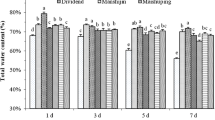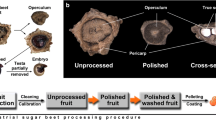Abstract
Different methods of sugar beet seed threshing have been used to improve the seed cultivation value. Two types of processing are common, including ordinary processing (seed size of 3.00–4.75 mm round sieve, coating with Gaucho insecticide) and special processing (seed size of 4.00–4.5 mm round sieve, and above 2.2 mm long sieve, coating with Cruiser insecticide). The present study was conducted to evaluate the effects of seed processing and plant density on quantitative and qualitative traits of sugar beet as a factorial experiment in a randomized complete block design with four replications in the crop year 2017–2018 in two regions of Karaj and Kermanshah. The first factor included the processing methods were ‘Shokoufa’ seeds with ordinary threshing and coating with Gaucho (a1) and Cruiser (a2), ‘Shokoufa’ seeds with special threshing and coating with Gaucho (a3) and Cruiser (a4) and seeds of cultivar F20909, and the second factor included the final plant density including 7, 10, and 13 plants per m2. The highest contents of impure (16.99%) and white sugar (8.23 t ha−1) and extraction coefficient of sugar (82.43%), and the lowest amounts of molasses (2.30%), harmful nitrogen (2.34 meq 100 g−1 beet), and potassium (4.97 meq 100 g−1 beet) were observed in F20909. Root yield, impure sugar yield, and white sugar significantly increased with increasing plant density. Regarding different areas of sugar beet cultivation, it was found that plants grown in Karaj had higher root yield (69.19 t ha−1), impure sugar (10.28 t ha−1), white sugar (7.58 t ha−1), harmful nitrogen (3.45 meq 100 g−1 beet), potassium (6.32 meq 100 g−1 beet), sodium (3.24 meq 100 g−1 beet), and molasses sugar (3.30%), while plants grown in Kermanshah had higher white and impure sugar content (16.55 and 14.14%), alkalinity (3.29), and extraction coefficient of sugar (84.84%).



Similar content being viewed by others
References
Abdollahian-Noghabi, M., R. Sheikholeslami, and B. Babaee. 2005. Technical terms of sugar beet quantity and quality. Sugar Beet Journal 21: 101–104. https://doi.org/10.22092/jsb.2005.8201.
Anonymous. 2017. Annual agricultural statistics of Iran. Ministry of Jihad-e-Agriculture of Iran
Bahrami, M., and M. Honarvar. 2017. The effect of environmental conditions, planting and harvest time on the quantity and technological values of beet sugars cultivated in west part of Iran. Journal Food Technology Nutrition 14: 49–62.
Baraloto, C., and P.M. Forget. 2007. Seed size, seedling morphology, and response to deep shade and damage in neotropical rain forest trees. American Journal Botany 94: 901–911. https://doi.org/10.3732/ajb.94.6.901.
Chegini, M., Sadeghzadeh Hemayati, S., Khodadadi, S., Jalilian, A., and Matloubi, F 2015. ‘Quantity and quality of sugar beet seed.’ (Agricultural Research, Education and Extension Organization (AREEO). Sugar Beet Seed Institute (SBSI)).
Chegini, M., and M. Etehad. 2010. The effects of seed grading, polishing and air- separation on some important seed characters of sugar beet monogerm cultivar gadouk seed. Sugar Beet Journal 31: 157–166.
Copeland, L.O., and M.F. McDonald. 2012. Principles of seed science and technology. Springer Science and Business Media. https://doi.org/10.1007/978-1-4615-1619-4.
Finch-Savage, W.E., and G.W. Bassel. 2016. Seed vigor and crop establishment: Extending performance beyond adaptation. Journal of Experimental Botany 67 (3): 567–591. https://doi.org/10.1093/jxb/erv490.
Hamidi, A., and M. Chegini. 2016. Effect of seed size of sugar beet varieties on some germination characters and seedling vigor. Sugar Beet Journal 31: 154–163. https://doi.org/10.22092/jsb.2016.105777.
Hoffmann, C.M., and B. Märländer. 2005. Composition of harmful nitrogen in sugar beet (Beta vulgaris L.): Amino acids, betaine, nitrate—as affected by genotype and environment. European Journal of Agronomy 22: 255–265. https://doi.org/10.1016/j.eja.2004.03.003.
Hoffmann, C.M., T. Huijbregts, N. Van Swaaij, and R. Jansen. 2009. Impact of different environments in Europe on yield and quality of sugar beet genotypes. European Journal of Agronomy 30: 17–26. https://doi.org/10.1016/j.eja.2008.06.004.
Ismail, A., and Allam, S. 2007. Yield and technological traits of sugar beet as affected by planting density, phosphorus and potassium fertilization, Proceedings of the 3rd Conference of sustainable agricultural development. Faculty of agriculture, Fayoum University, Pakistan.
ISTA. 2013.'International rules for seed testing: seed health testing methods is the supplement to chapter 7 International rules for seed testing; edition 2013; catalogued separately. (International Seed Testing Association)
Jafarnia, B., R. Ghorbani, A.Z. Feizabady, and A.R. Ghaemi. 2013. Impact of crop density and soil fertilization on sugar beet. International Journal of Agriculture and Crop Sciences 5: 2991–2999.
Johnson, B.L., and B.K. Hanson. 2003. Row-spacing interactions on spring canola performance in the northern great plains. Agronomy Journal 95: 703–708. https://doi.org/10.2134/agronj2003.7030.
Kenter, C., C.M. Hoffmann, and B. Märländer. 2006. Effects of weather variables on sugar beet yield development (Beta vulgaris L.). European Journal of Agronomy 24: 62–69. https://doi.org/10.1016/j.eja.2005.05.001.
Khayamim, S., D. Mazaher, M. Banaian Aval, J. Govhari, and M.R. Jahansooz. 2003. Assessment of sugar beet physiologic and technologic characteristics at different plant density and nitrogen use levels. Journal of Pajouhesh and Sazandegi 60: 21–29.
Kimmelshue, C.L., S. Goggi, and K.J. Moore. 2022. Seed size, planting depth, and a perennial groundcover system effect on corn emergence and grain yield. Agronomy 12 (2): 437. https://doi.org/10.3390/agronomy12020437.
Lukaszewska, E., R. Virden, and E. Sliwinska. 2012. Hormonal control of endoreduplication in sugar beet (Beta vulgaris L.) seedlings growing in vitro. Plant Biology 14: 216–222. https://doi.org/10.1111/j.1438-8677.2011.00477.x.
Marey, S. 2015. Affecting each of ridger furrow opener parameters and planting methods on water use efficiency and sugar beet yield. Bulgarian Journal of Agricultural Science 21: 1304–1311. https://doi.org/10.21608/jssae.2014.49601.
Marinković, B., M. Grujić, D. Marinković, J. Crnobarac, J. Marinković, and G. and D.V. Jaćimović, Mircov. 2008. Use of biophysical methods to improve yields and quality of agricultural products. Journal of Agricultural Sciences 53: 235–242. https://doi.org/10.2298/JAS0803235M.
Masri, M. 2008. Effect of nitrogen level and planting density on sugar beet yield and its attributes. Egyptian Journal of Agronomy 30: 119.
Milford, G., M. Armstrong, P. Jarvis, B. Houghton, D. Bellett-Travers, J. Jones, and R. Leigh. 2000. Effect of potassium fertilizer on the yield quality and potassium offtake of sugar beet crops grown on soils of different potassium status. The Journal of Agricultural Science 135: 1–10. https://doi.org/10.1017/S0021859699007881.
Mohammadnia, M., A. Soleymani, A. Shiranirad, and M. Naderi. 2006. Effect of planting pattern on white sugar yield and components of two cultivars sugar beet. The Journal of Agricultural Science 12: 75–85. https://doi.org/10.3390/agronomy9070405.
Olsson, R. 2012. Insecticide seed treatments against pests in sugar beet. NBR (Nordic Beet Research). Report from Syngenta Seeds AB (No. 450–2012). Report.
Paravar, A., R. Piri, H. Balouchi, and Y. Ma. 2023. Microbial seed coating: an attractive tool for sustainable agriculture. Biotechnology Reports 37: 1–15. https://doi.org/10.1016/j.btre.2023.e00781.
Rašovský, M., V. Pačuta, L. Ducsay, and D. Lenická. 2022. Quantity and quality changes in sugar beet (Beta vulgaris provar. Altissima doel) induced by different sources of bio stimulants. Plants 11 (17): 2222. https://doi.org/10.3390/plants11172222.
Refay, Y. 2010. Root yield and quality traits of three sugar beet (Beta vulgaris L.) varieties in relation to sowing date and stand densities. World Journal of Agricultural Sciences 6: 589–594.
Rocha, I., Y. Ma, P. Souza-Alonso, M. Vosátka, H. Freitas, and R.S. Oliveira. 2019. Seed coating: a tool for delivering beneficial microbes to agricultural crops. Frontiers in Plant Science 10: 1357. https://doi.org/10.3389/fpls.2019.01357.
Rochalska, M., and A. Orzeszko-Rywka. 2008. Influence of alternating magnetic field on respiration of sugar beet seeds. International Agrophysics 22: 255–259.
Sadeghi, H., F. Khazaei, S. Sheidaei, and L. Yari. 2011. Effect of seed size on seed germination behavior of safflower (Carthamus tinctorius L.). Journal of Agriculture and Biological Sciences 6: 5–8.
Salimi, Z., and B. Boelt. 2019. Optimization of germination inhibitors elimination from sugar beet (Beta vulgaris L.) seeds of different maturity classes. Agronomy 9 (11): 763. https://doi.org/10.3390/agronomy9110763.
Scott, D., and R.J. Hay. 1974. Some physical and nutritional effects of seed coating. In Proceedings of 12th International Grassland Congress. pp 523–531, Moscow, Russia.
Sohail, M., T. Pirzada, C.H. Opperman, and S.A. Khan. 2022. Recent advances in seed coating technologies: Transitioning toward sustainable agriculture. Green Chemistry 24 (16): 6052–6085. https://doi.org/10.1039/D2GC02389J.
Steinbrecher, T., and G. Leubner-Metzger. 2017. The biomechanics of seed germination. Journal of Experimental Botany 68: 765–783. https://doi.org/10.1093/jxb/erw428.
Taleghani, D.F., M. DehghanShoar, A. Ghasemi, V. Yossefabadi, M.A. Chegini, M. Mesbah, and F. Hamdi. 2003. Determination of optimum seed size and quantity of peleting materials for monogerm sugar beet seed. Sugar Beet Journal. 18: 95–108. https://doi.org/10.22092/jsb.2003.8276.
Taleghani, F., Khayamim, D., Hosseinpur, S., and Moharramzadeh, M 2006. Planting date and density of the sugar beet plant. Sugar Beet Seed Institute.
Tavakoli-Kakhki, H., and A. Beheshti. 2010. Wheat seed treatment and its effect on seed vigor indices from bioenvironmental aspect. Agroecology 2: 185–192. https://doi.org/10.22067/jag.v2i1.7616.
Varga, I., Z. Lončarić, S. Kristek, A.M. Kulundžić, A. Rebekić, and M. Antunović. 2021. Sugar beet root yield and quality with leaf seasonal dynamics in relation to planting densities and nitrogen fertilization. Agriculture 11 (5): 407. https://doi.org/10.3390/agriculture11050407.
Zhang, K., Z. Khan, Q. Yu, Z. Qu, J. Liu, T. Luo, and L. Luo. 2022. Biochar coating is a sustainable and economical approach to promote seed coating technology seed germination plant performance and soil health. Plants 11 (21): 2864. https://doi.org/10.3390/plants11212864.
Author information
Authors and Affiliations
Corresponding author
Ethics declarations
Conflict of interest
The authors declare that they have no known competing financial interests or personal relationships that could have appeared to influence the work reported in this paper.
Additional information
Publisher's Note
Springer Nature remains neutral with regard to jurisdictional claims in published maps and institutional affiliations.
Rights and permissions
Springer Nature or its licensor (e.g. a society or other partner) holds exclusive rights to this article under a publishing agreement with the author(s) or other rightsholder(s); author self-archiving of the accepted manuscript version of this article is solely governed by the terms of such publishing agreement and applicable law.
About this article
Cite this article
Safari, A., Hemayati, S.S., Moballeghi, M. et al. Seed Coating: A Sustainable Way to Compensate for the Loss of Plant Number Per Unit Area in Sugar Beet Fields. Sugar Tech (2024). https://doi.org/10.1007/s12355-023-01349-x
Received:
Accepted:
Published:
DOI: https://doi.org/10.1007/s12355-023-01349-x




